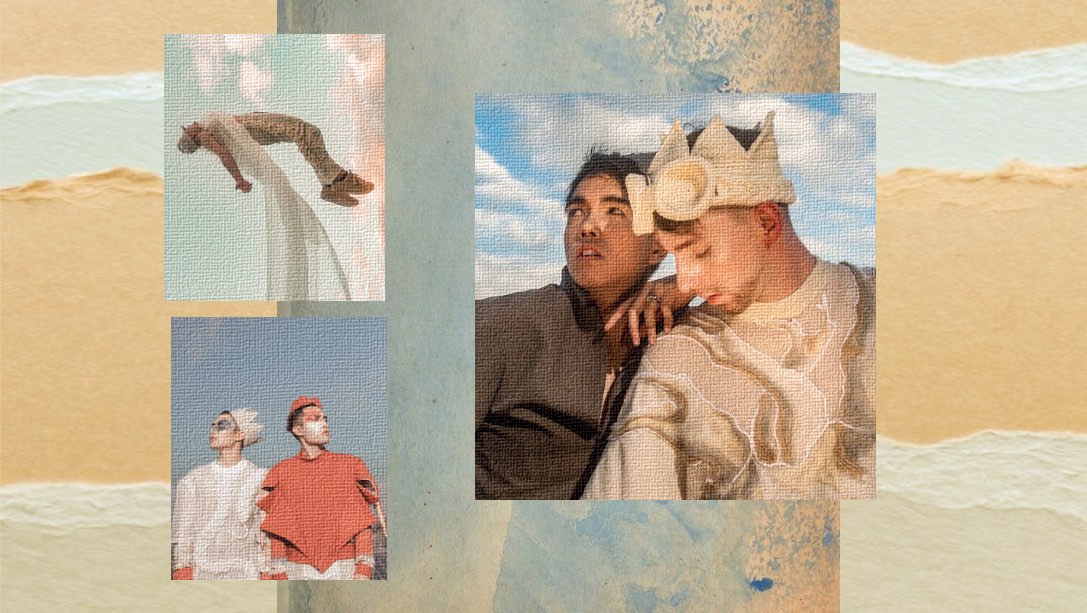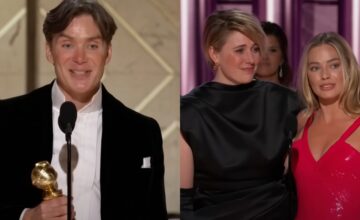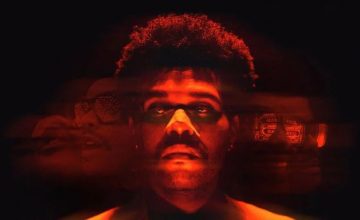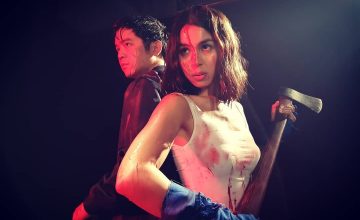“At a very young age, I practiced what I preached. It was hard fighting it alone, but the habits I slowly developed from that day led me to gravitate to sustainable fashion,” explains 25-year-old Cebuano designer Jann Bungcaras. Back in elementary, he saw the documentary “Six Degrees: Could Change The World.” It gave him a new perspective on climate change and how every little action he does affect the world.
Since then, his carbon footprint in check while bringing his designs to life. He’s an environmentalist first and a designer second.
The Bench Design Awards’ alumni is a semi-finalist for The Redress Design Awards, a global competition that aims to raise awareness on climate change. For the global fashion industry, one way of solving the crisis is through discovering new talents and encouraging sustainable practices.
The young Cebuano fits the bill perfectly. His sustainable practices and playful collections give his prêt-à-porter and custom wear an edge on the runway.
With strings of threads and upcycled textiles instead of lofty paragraphs, Bungcaras’ collections are storybooks in a league of their own—and the global sustainable industry is starting to notice.
“My designs are seemingly a reflection of my story told in different ways. My clothes do not follow a gender construct. I believe that clothing must be a form of art; therefore, it gives awareness of other forms of art,” explains Bungcaras’ use of handicrafts. “Lastly, I believe that fashion should impact the environment positively; therefore, even during the design process, the materials and waste created should be directed to that goal.”
He sees his designs as paintings of his biography and beliefs. Bungcaras’ designs aren’t afraid to have a childlike wonder that goes beyond the box, incorporating handicrafts like knitting, crocheting and felting. This is embodied by his previous collections like “Howling: A Wolf’s Longing Runway” and “Wanderings of a Child Prince.”
It’s not just a simple drop or a release for the sake of it. With strings of threads and upcycled textiles instead of lofty paragraphs, Bungcaras’ collections are storybooks in a league of their own—and the global sustainable industry is starting to notice.
Although his approach stands out, it’s the stories weaved into his pieces that pull you in. We got a chance to talk to this promising designer about his intricate yet organic pieces, the Cebuano fashion scene and the future of Filipino sustainable fashion.
What is the first word you want others to associate with your designs?
As a Libra, I’m always indecisive. I’m usually torn between being emotional and conceptual. Emotional, because that was always my goal, to make people feel something every time my looks walk down the runway. Conceptual, because that is the essence of my work. I breathe concepts. I don’t just make clothes, I tell stories through clothing.
Who can wear your designs?
I’m not a businessman. I design because it’s what keeps me alive. So, during my design process, I picture people who aren’t afraid of their unique selves to wear my clothes.
In its most basic purpose, clothes are forms of armor to hide vulnerability, while mine exposes them. Each of my clothes portrays a chapter of the collection’s story. Having this ideology, it creates an emotional conversation between me and whoever wears it. The one who wears it is not afraid of their inner or true self.
What are the pros and cons of doing sustainable fashion?
The benefit of sustainable fashion is evident in both the wearers and the environment. These clothes were created from upcycled textile waste. It can come from organic biodegradable materials, or produced in a zero or low-waste manner. In other words, the positive by-product of sustainable fashion is that a buyer or designer has contributed favorably to the environment.
The disadvantage is in sourcing and ethical production. Since we are dealing with waste, we have to make sure that these materials have a long and durable lifespan. As a sustainable brand, we take measures to reduce waste as much as possible.
“In its most basic purpose, clothes are forms of armor to hide vulnerability, while mine exposes them.”
It makes the production process longer since the products are mass-produced and mass-treated. The disadvantages are usually hidden by other fashion houses. But in this side of fashion, the sacrifices of sustainable designers to remain true to their voices is worth showing. Fashion is not a clean industry, it can be used to raise awareness as well.
How does Cebu influence your craft?
My connection to the city seeps through my clothes. With Cebu being the first city colonized by Spain and the first to fight them off, my collections tend to be a little bit historic. They have a Filipino-Spanish flair, which is more apparent in the modern barongs in my first collection.
What makes the Cebu fashion scene stand out?
I suppose what makes us stand out is our drive for our craft and recognition. Being kilometers away from the capital is often an inconvenience for us, when we want to gain fashion opportunities in the national or international scenes. That’s why we work harder just for our crafts to be acknowledged.
Looking inward, Cebu offers so much natural materials and skilled artisans. It creates a strong bond between each member of our supply chain. By adding a pinch of familial love, it gives our finished products another story to tell.
How did your taste or collections evolve since you started?
It’s only been more than a year since my first ever collection at Bench Design Awards 2018 launched. Since then, I noticed how emphatic I’ve become. With my first collection, I relate to the Aviator who was confronted by his younger self, portrayed as the Little Prince.
My second collection “Howling: A Wolf’s Longing” presented during the FIP Fashion Week told a different story of the wolf. It involves someone who was misunderstood, someone who is not cross-dressing for the sake of it, but someone who is simply living their truth. It raised transexual awareness days after the Diez vs. the janitress incident. My collection for the Redress Design Awards is also inspired heavily by our failures.
“We should buy less from brands that are disastrous and unethical to the environment and its people.”
Could you give us a sneak peek of your collection for the design awards?
The collection is divided into three looks: Adam’s Dominion over the Sea, over the Earth and over the Skies.
The collection is made mostly from reconstructed fast-fashion garments I owned for more than five years, as a metaphor of turning past mistakes into present solutions. The other materials used are textile-wastes rescued from industry warehouses and landfills. As I became more involved in this industry, I became more and more sustainable when I discovered more sources of materials and learned more ways of upcycling.
Where do you want to take Filipino sustainable fashion?
I also want to normalize sustainable fashion. To some, the label “sustainable” can come off as pretentious because in all the things we do, we still create waste. This is true, but it is how we minimize creating waste that matters more.
Along the supply and production chain, we have different decisions to make. We could easily order raw materials from suppliers or we could rescue surplus or thrown textiles, we could mass-produce our garments or we could do slow-fashion production assuring that all garments will be sold and done accurately. These are only among the many choices we go through during our production, which will result in a large impact to the environment after.
Is the future of Filipino fashion sustainable?
Fashion contributes to 10 percent of carbon emissions annually. Given these facts, and hoping that the country’s fashion moguls care about others, I can answer this question with positivity. But positivity without action is just false hope.
Read more: Mercado Vicente is the “digital palengke” connecting Filipino artists to the world
To truly change the business scale of fashion, we have to change our habits as consumers. We should buy less from brands that are disastrous and unethical to the environment and its people. We shouldn’t be blinded by sales and discounts that would turn into waste stored in our closets, or tempted to buy products endorsed by someone we adore. To sum it up, we have to be mindful buyers.
For a sustainable future to happen, we must act now. And luckily, some of us did.
To help elevate his chances to be in The Redress Design Awards finals, you can vote for Jann Christian Bungcaras here.
This story is part of our #SeenOnScout series, which puts the spotlight on young creatives and their body of work. Jann and many other creatives shared their work at our own community hub at Scout Family and Friends. Join the Scout Family & Friends Facebook group right here, and share your work with us in the group or through using #SeenOnScout on Twitter and Instagram.
Read more:
My ECQ coping mechanism is dressing up (even though I don’t need to
“Yeet” is a Cebu artist’s exhibit on meme culture and shitposting
The many meanings of ‘giatay,’ explained in this Art Fair exhibit
Art by Rogin Losa

























Comments